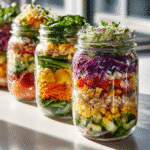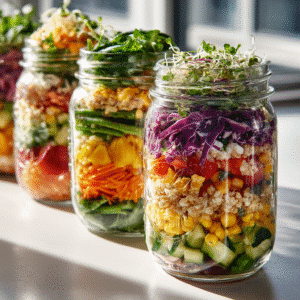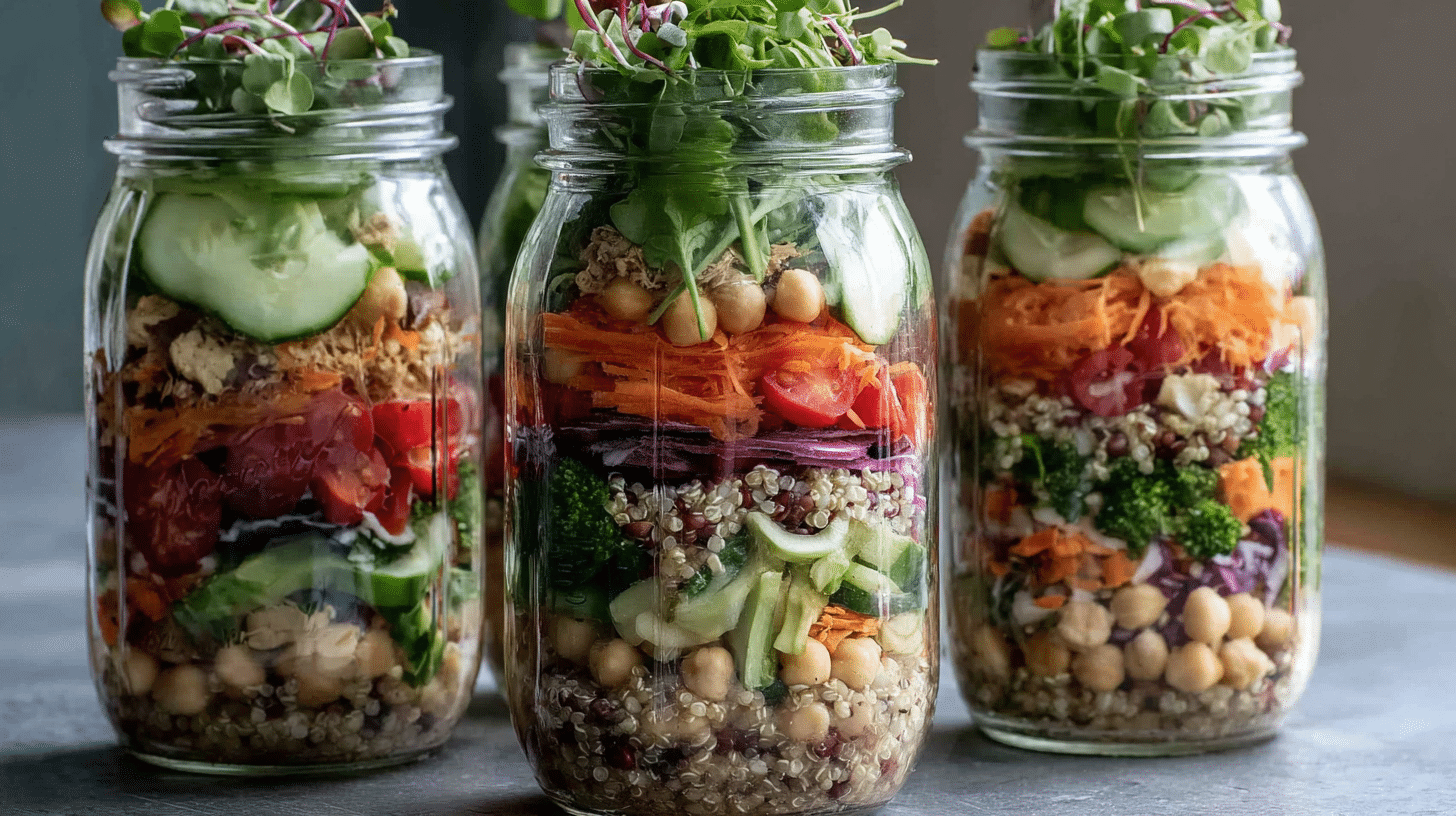
Mason jar salads (gluten-free) have become a popular choice for people seeking fresh, healthy meals on the go. These salads combine convenience with nutrition, making them ideal for busy schedules and gluten-free lifestyles. This article will guide you through the benefits, ingredients, preparation, and storage tips for mason jar salads that are free from gluten. Whether you’re new to mason jar salads or looking for new ideas, you’ll find practical advice to make delicious and safe gluten-free meals.
Benefits of Mason Jar Salads (Gluten-Free)
Why Mason Jar Salads Are Perfect for Gluten-Free Diets
Mason jar salads provide an excellent option for anyone following a gluten-free diet. By preparing your own salad jars, you can carefully select ingredients free from gluten, avoiding hidden sources common in pre-made salads. The sealed jars keep salads fresh longer and help prevent cross-contamination, which is important for those sensitive to gluten. This method offers a convenient, portable, and safe way to enjoy healthy meals that suit a gluten-free lifestyle.
Nutritional Advantages of Mason Jar Salads
These Mason jar salads (gluten-free) combine fresh vegetables, proteins, and healthy fats, creating balanced meals that support overall wellness. By making mason jar salads yourself, you control calories, salt, and sugar, ensuring each gluten-free meal fits your nutritional needs perfectly. Including ingredients like leafy greens, grilled chicken, nuts, or beans boosts fiber and protein content. Mason jar salads (gluten-free) are not only convenient but also help maintain a wholesome and safe gluten-free diet.
Mason jar salads (gluten-free) make healthy meals easy and fresh for days. Layer ingredients right for a crisp salad anytime. For more quick gluten-free meals, see our Easy Gluten-Free Sides.
Choosing Ingredients for Mason Jar Salads (Gluten-Free)
Best Gluten-Free Ingredients for Mason Jar Salads
Selecting the right ingredients is crucial when preparing Mason jar salads (gluten-free). Start with fresh vegetables like spinach, kale, cucumbers, carrots, and bell peppers to add crunch and vibrant colors. Proteins such as grilled chicken, boiled eggs, chickpeas, and quinoa provide substance and keep the salad filling while staying gluten-free. Adding nuts and seeds enhances texture and supplies healthy fats; however, make sure they come from gluten-free sources to avoid contamination. Toppings like avocado and gluten-free cheese bring extra creaminess and flavor to your mason jar salads.

How to Avoid Cross-Contamination with Gluten
Avoiding cross-contamination is essential for anyone on a gluten-free diet. When making mason jar salads, use separate cutting boards, knives, and utensils to prevent gluten particles from transferring. Wash hands thoroughly before handling ingredients and always check labels on processed foods such as dressings, canned beans, or packaged nuts. Keeping gluten-free ingredients stored separately from gluten-containing foods also helps minimize risk. Following these precautions ensures your mason jar salads remain safe and gluten-free every time.
Step-by-Step Mason Jar Salad Preparation
Layering Ingredients for Freshness and Flavor
When preparing Mason jar salads (gluten-free), how you layer ingredients matters. Start by adding the dressing at the bottom to keep the rest of the salad crisp. Next, add firm vegetables like carrots, cucumbers, and bell peppers that won’t absorb moisture quickly. Follow with proteins such as grilled chicken or beans, then softer vegetables and toppings like avocado or cheese. Finally, place the leafy greens on top to prevent wilting. This layering technique keeps mason jar salads fresh and tasty until you’re ready to eat.

Tips for Packing Mason Jar Salads to Prevent Sogginess
Preventing sogginess is key to enjoying Mason jar salads (gluten-free). Besides layering correctly, make sure ingredients are dry before packing. Use paper towels to remove excess moisture from vegetables and lettuce. Avoid watery ingredients like tomatoes or cucumbers unless well drained. Seal jars tightly and store them upright in the fridge. These simple steps help maintain the texture and flavor of your mason jar salads, making each meal enjoyable and satisfying. For extra protein in your mason jar salads (gluten-free), try ideas from our high-protein gluten-free breakfasts for easy, nutritious options.
Gluten-Free Salad Dressing Options for Mason Jar Salads
Homemade Gluten-Free Dressing Recipes
Making your own gluten-free salad dressings gives you full control over ingredients and flavors. Simple dressings using olive oil, lemon juice, vinegar, and herbs can complement mason jar salads without adding gluten or unnecessary additives. Mixing mustard, honey, or fresh garlic with basic oils and vinegars creates tasty dressings that keep your salads fresh and safe. Homemade dressings stay fresh longer when stored in airtight containers and avoid preservatives often found in store-bought versions.
Store-Bought Gluten-Free Dressings: What to Look For
When buying dressings, check labels carefully to ensure they are gluten-free. Some dressings may contain hidden gluten from additives or thickeners. Look for certifications or clear gluten-free labeling on packaging. Choose dressings with simple, natural ingredients and avoid those with wheat-based stabilizers. Popular gluten-free options include balsamic vinaigrette, ranch made without gluten, and tahini-based dressings. Always store opened dressings in the refrigerator and use within the recommended time.
Storing and Transporting Mason Jar Salads
How Long Do Mason Jar Salads Last in the Fridge?
Mason jar salads (gluten-free) can stay fresh in the refrigerator for up to five days when stored properly. Keeping the dressing at the bottom and greens at the top helps maintain crispness. Make sure the jars are sealed tightly to prevent air from spoiling the ingredients. For best taste and texture, consume your mason jar salads within three days, especially if they include delicate ingredients like avocado or soft cheeses.
Best Practices for Carrying Mason Jar Salads on the Go
Transporting mason jar salads is easy but requires a few precautions. Always keep the jars upright to avoid spilling the dressing. Use insulated lunch bags or cooler packs to maintain freshness, especially in warmer weather. Glass mason jars are sturdy but consider protective sleeves to prevent breakage. Preparing salads the night before ensures they are ready to grab and go, making healthy eating convenient wherever your day takes you.
Popular Gluten-Free Mason Jar Salad Recipes
Classic Mediterranean Mason Jar Salad
The classic Mediterranean mason jar salad combines fresh cucumbers, cherry tomatoes, Kalamata olives, red onions, and feta cheese over a bed of mixed greens. Toss in some grilled chicken or chickpeas for added protein. Dress with a simple olive oil and lemon vinaigrette. This salad offers vibrant flavors and is naturally gluten-free, making it a popular choice for mason jar salads (gluten-free) that are both satisfying and nutritious.

Protein-Packed Mason Jar Salad for Busy Days
For a filling gluten-free mason jar salad, layer cooked quinoa, black beans, corn, diced bell peppers, and avocado. Add shredded chicken or hard-boiled eggs for extra protein. Use a tangy cilantro-lime dressing to enhance the flavors. This hearty salad is perfect for busy days when you need a quick, balanced meal that stays fresh and gluten-free until mealtime.
Addressing Common Questions About Mason Jar Salads (Gluten-Free)
Are Little Salad Bar Salads Gluten-Free?
Many people wonder if little salad bar salads are gluten-free, especially compared to homemade mason jar salads (gluten-free). Unfortunately, salad bar options often carry a higher risk of cross-contamination due to shared utensils, dressings, and toppings that may contain gluten. In contrast, mason jar salads (gluten-free) prepared at home let you control every ingredient and avoid hidden gluten. This control makes mason jar salads a safer choice for anyone needing strict gluten-free meals.
Mason jar salads (gluten-free) help avoid gluten cross-contamination found in salad bars. For more gluten-free meal ideas, visit our One-Pan Gluten-Free Meals.
Why Do People Put Salads in Mason Jars?
People choose Mason jar salads (gluten-free) because they offer convenience, portion control, and freshness. The airtight seal of mason jars preserves the ingredients, keeping salads crisp for days without wilting. Mason jar salads also make packing lunches simple and mess-free, perfect for gluten-free diets that require careful ingredient management. Many enjoy mason jar salads as a practical way to enjoy healthy, gluten-free meals anytime, anywhere.
FAQs
Which Salads Are Gluten-Free?
Many salads can be naturally gluten-free, including those made with fresh vegetables, fruits, nuts, seeds, and gluten-free proteins. Mason jar salads (gluten-free) often use these safe ingredients to create healthy meals. Avoid salads with croutons, certain dressings, or processed toppings that may contain gluten unless clearly labeled gluten-free. Always check ingredient lists when purchasing pre-made items to keep your salad safe.
Are little salad bar salads gluten-free?
Little salad bar salads may not always be gluten-free due to potential cross-contamination. Shared utensils, dressings, and toppings can introduce gluten. If you have gluten sensitivity or celiac disease, it’s safer to prepare your own mason jar salads (gluten-free) at home to control ingredients and avoid gluten exposure.
Why do people put salads in mason jars?
People use mason jars for salads because they keep ingredients fresh and crisp longer. The airtight seal prevents wilting and sogginess by separating dressing from other ingredients until you’re ready to eat. Mason jar salads are portable, easy to pack, and perfect for gluten-free diets requiring careful ingredient control.
How Long Will a Salad Last in a Mason Jar?
When properly prepared and stored, mason jar salads (gluten-free) can last up to five days in the refrigerator. Keeping the dressing at the bottom and greens at the top helps maintain crispness. Ingredients like avocado or soft cheese may shorten the salad’s shelf life, so consume those jars sooner. Always seal jars tightly to keep air out and maintain freshness.
Conclusion
Mason jar salads (gluten-free) offer a fresh, convenient way to enjoy healthy meals without worrying about gluten. They allow full control over ingredients, reducing the risk of hidden gluten and cross-contamination. With the right preparation, ingredient choices, and storage, these salads stay crisp and tasty for several days. Whether you’re packing lunch for work, school, or on-the-go, mason jar salads (gluten-free) provide a simple, nutritious option that fits any lifestyle. For more inspiring mason jar salad ideas and gluten-free meal tips, check out related boards on Pinterest, creative posts on Tumblr, quick recipe shares on X (Twitter), and detailed guides on Medium.
Meet Emily Culino
Emily Culino is a passionate food blogger and recipe developer known for creating wholesome, easy-to-make meals that fit busy lifestyles. She shares vibrant recipes and practical cooking tips that inspire home cooks to enjoy nutritious and delicious food every day.
Table of Contents

Classic Mediterranean Mason Jar Salad (Gluten-Free)
Equipment
- 1-pint mason jar with lid
- measuring spoons
- cutting board and knife
- small bowl (optional for mixing dressing separately)
Ingredients
- 2 tbsp olive oil
- 1 tbsp fresh lemon juice
- 0.25 tsp dried oregano (optional)
- 0.25 tsp sea salt
- 0.25 tsp black pepper
- 0.5 cup cherry tomatoes, halved
- 0.5 cup cucumbers, sliced
- 0.25 cup Kalamata olives, pitted and halved
- 0.25 cup red onion, thinly sliced
- 0.5 cup chickpeas or grilled chicken (cooked)
- 0.25 cup crumbled feta cheese
- 1 cup mixed salad greens
Instructions
- Add the olive oil, lemon juice, oregano (if using), salt, and pepper to the bottom of a clean mason jar.
- Layer in cherry tomatoes and cucumber slices as the first layer above the dressing.
- Add Kalamata olives and sliced red onions next.
- Add your protein choice: cooked chickpeas or grilled chicken.
- Top with crumbled feta cheese for creamy texture and tangy flavor.
- Finish with a layer of mixed salad greens. Seal the jar tightly and refrigerate upright.
- When ready to eat, shake the jar to distribute the dressing, or pour into a bowl and toss lightly.

